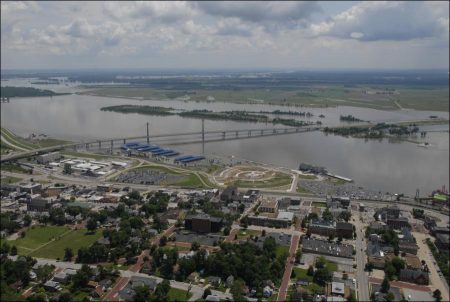Alton (488 alt., 34,511 pop.), just above the confluence of the Mississippi and the Missouri, and just below that of the Illinois and Mississippi, rises on the bluffs where they retreat from the river to mark the head of a vast river plain known as the American Bottom. From this point south to East St. Louis, in a great thirty-mile arc that follows the river, is an almost continuous manufacturing area. Although it benefited, along with East Alton, Wood River, and Granite City, from the great industrial expansion of the first part of the twentieth century, Alton differs sharply from its sister cities in that its growth was spread over more than a century.
Alton works in the valley and lives on the hill. The main business district fronts on the river at the west part of the city; at the eastern limits, where the valley flares wide, lies a cluster of sprawling plants that manufacture glass, lead, steel, chemicals, box-board, and scores of other products.
Residential Alton lies chiefly back from the river on the bluffs. Here the expression “going downtown” has literal meaning, for the streets that run to the river drop abruptly on a steep grade from immediately above the business district. The central section, with its unusually wide streets (many still surfaced with brick) and Victorian houses that give each other elbow room, retains the spaciousness and faintly lavender scented dignity of the nineteenth century. Many of the older houses, built during steamboat days, are surmounted with lookout platforms that vary from a mere fenced-in rectangle to elaborate circular and octagonal cupolas.
In the middle of the last century crack steamboats, such as the Golden Eagle, the Gossamer, and the Kate Kearney, vied with each other on the stretch between St. Louis and Alton, where a rich load of freight usually awaited the first steamer to dock. The lookout stations were an architectural outgrowth of this racing mania. Merchants awaiting shipments and persons who gambled on the races built observation towers on their stores and houses from which, even at a distance, to view the outcome. At length the observation platforms became ornamental rather than functional, and many of them today cap houses completely out of sight of the river.
Although the site of Alton had been passed by Marquette and Jolliet on their voyage down the Mississippi in 1673, the first known settler, Jean Baptiste Cardinal, did not come to the vicinity until 110 years later. By the beginning of the nineteenth century an Indian trading post had been established. The site was obviously suitable for a permanent settlement, for above it the bluffs closed in on the river and for miles there was no sufficient setback for a boat landing.
The confluences of the two great rivers nearby marked the spot as an eventual focal point for river traffic. Between 1816 and 1818 three towns, hoping to capitalize these advantages, were founded in the area now included in the Alton city limits. One of these, now the downtown business district, was planned by Col. Rufus Easton and named Alton for one of his sons. Proving to be the most satisfactory for river trade, his town eventually absorbed the other two, and Alton was incorporated as a city in 1837.
The first major period in its development coincided with the ascendancy of steamboat transportation, and for a time its wharfs teemed with white steamboats and Alton rivaled St. Louis as a river port.
Lying just north of a section where slavery was favored, Alton felt many of the repercussions from the slavery dispute; here, in 1837, Elijah Lovejoy, noted Abolitionist editor, was murdered while protecting his press from the onslaught of a pro-slavery mob.
Alton was again the focus of the slavery question in 1858, when the last of the Lincoln-Douglas debates was held here. Altonians were already familiar with Lincoln because of the seriocomic Lincoln-Shields duel of 1842. Mary Todd, whom Lincoln later married, had lampooned State Auditor of Accounts James Shields in a Springfield paper; and Lincoln assumed responsibility for the article and was challenged by Shields.
Lincoln chose broadswords, and Alton as the duelling ground. With a crowd of the curious they rowed to a sandbar in the river. The lanky Abe practiced swings and told stories while the seconds conferred at great length, but the duel did not take place. Shields finally accepted a formal statement that although Lincoln “did not think… that said article could produce such an effect,” he had not intended “injuring the personal or private character or standing of Mr. Shields.”
Alton has seen a steady increase in population each decade for more than 100 years. The decline of steamboating at the end of the nineteenth century was offset by the rise of industrial plants, notably that of the Owens-Illinois Company, which grew from a one-building concern tucked way in the bluffs to its present position as the dominant corporation among the nation’s glass-producers. And as other plants began to smoke on the river plain, Alton listened to the gradual diminishing of the steamboat’s hoot with only the regret occasioned by the passing of a colorful era.
Visits: 141



